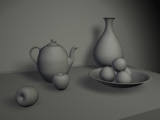

|
| Syllabus
|
| Project 02 | Digital Lighting of Objects |
assignment
description image by Yootai Kim |
Time of Day Still Life This project mirrors the experience students had on Project 1 using physical lighting by applying the fundamental principles and elements of lighting for computer imagery to a simple scene of virtual objects. Properties of light that will be explored are intensity, direction, shape, color, filtering and quality. The focus is on the simulation of time of day (morning, evening and noon) through light quality and quantity, and the use of basic light types. By varying only the lighting, the two images should visually communicate time of day as specified. Each group is assigned a virtual still life composition consisting of a range of objects situated on a table placed above a floor treatment. The models and surface materials are provided and must be used. Use color in lights to support the time of day. Incorporate key, fill, and kicker lights. Feel free to use additional lights (e.g. extra keys, backlights, diffuse lights), but add additional lights cautiously. Every light should have a purpose! Include lights that provide bounce. For this assignment: 1. Render one image for each setup (morning, evening and noon) at video resolution (640x480). The composition, determined by the virtual camera placement must be the same in all images. 2. Assemble the images with a cross-dissolve transition between them in Adobe Premiere to create a 3-5 second Quicktime movie file. 3. Create diagrammed stills that document and label light placement for each setup. Use top and front/side views. |
| requirements | In each image, address form or surface modeling , and composition through the use of lighting intensity, direction, shape, color, filtering and quality.
Assign team members to various roles for the execution and presentation of the images and animation. Your images should vary in light properties: Intensity, Direction, Shape, Color, Filtering, and Quality. Your images should vary in light placements and types and include shadows, bounce light and atmosphere. Your images should present a strong composition through the camera placement. |
| grading criteria |
Final grades will be
based on: 1. communication of time of day through lighting 2. composition 3. technical execution of appropriate lighting properties and rendering 4. artistic effectiveness and expression of the object forms through lighting |
| documentation |
Three digital image files (morning, evening and noon), at 640x480 resolution. The images will
eventually be posted on your web page and dropped in the course dropbox at Y://Courses/AC693_Palazzi_Spring_2004 A 3-5 second animation (320x240) that transitions between the 3 stills. The movie file will be posted on your web page and dropped in the course dropbox at the above location. diagrammed stills that document and label light placement for each setup. |
| readings | Digital + Physical Lighting Course Packet pg. 7 The Art of Maya, Digital Cinematography pg. 11-39 Siggraph '96 - Storytelling through Lighting pg. 43-67Siggraph '96 - Lighting for Computer Graphics pg. 119 - 149 Learning Maya, Lighting pg. 59 - 68 Inspired 3D Lighting and Composition, Lighting Basics |
| Syllabus
|
| Copyright 2001 Advanced Computing Center for the Arts and Design and the Department of Theatre The Ohio State University |